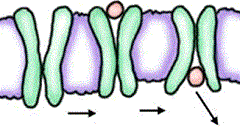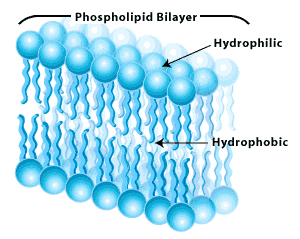totaled 10/26 Mr F
Lipid Bilayer
- Main component of cell membranes
- Gives membranes its fluid properties
- Fatty acids tails sandwiched between hydrophilic heads

- Split membranes reveal embedded protiens
Fluid Mosiac Model
- membrane is a mosiac of
- phospholipids
- glycolipids
- serols
- proteins
- most phospholipids and some proteins can drit through membranes
Terms
solvent: doing the dissolving (its the majority) (in biology its almost always H20!)
solute: being dissolved
mixture: insoluble in solvent
Concentration Gradient
- Means the number of molecules or ions in one region is different than the number in another region
- In the absence of other forces, a substance moves from a region where it is more concentrated to one where it's less concentrated - down gradient
Diffusion
- The net movement of like molecules or ions down a concentration gradient
- Although molecules collide randomly, the net movement is away from the place with the most collisions
Factors Affecting Diffusion Rate
- Steepness of concentration gradient
- Steeper gradient, faster diffusion
- Molecular Size
- smaller molecules, faster diffusion
- Temperature
- higher temperature, faster diffusion
- Electrical or pressure gradients
Membrane Crossing Mechanisms
- Diffusion across lipid bilayer
- Passive transport
- active transport
- endocytosis
- exocytosis
Selective Permeability - Allows something in and keeps other out
- -Small non polar molecutes (02, CO2) can make it through the cells
- -Glucose and other large, polar, water soluable molecules; ions and water molecules can't pass through
ATP
- An enzyme that catalyzes the hydrolysis of ATP to ADP, releasing energy that is used in the cell; adenosine triphosphatase.
Passive and Active transport
Passive
- Doesn't require energy inputs (ATP)
- Solutes diffuse through a channel inside the protein's interior
- Net movement is down concentration gradient
Moving from a higher concentration to a lower one is natural so it requires no energy. It's the cells way of creating equilibrium.

Active
- Requires ATP
- Protien is an ATPase pump
- Pumps solute against its concentration gradient
- Always across a cell membrane
Because molecules usually move from a high concentration to a lower one, when it's doing the reverse it requires energy.

Transport Proteins
- Span the lipid bilayer
- Interior is able to open to both sides
- Change shape when they interact with solute
- Move water soluble substances across a membrane

Osmosis
- Water molecules tend to diffuse down water concentration gradient
- Total number of molecules or ions dictates concentration of H2O
- Osmosis only occurs if you can't difuse
- Tonicty- relative solute concentration

Diffusion - Movement of H2O molecules through a semi permeable membrane towards a high concentration of solute
- Isotonic - [solute] =
- Hypertonic [solute] is high
- Hypotonic [solute] is low
-If you have a hypertonic region you must have a hypotonic region and it all tries to be isotonic
Facilitated Diffusion (Shown here: http://highered.mcgraw-hill.com/sites/0072495855/student_view0/chapter2/animation__how_facilitated_diffusion_works.html): Is when a carrier protein that is in the cell membrane helps molecules in and out of cells that cant pass through normally. The molecule attatches to the protein, then the protein changes its shape and "pushes" the molecule out of the protein and into the cell past the membrane. If the molecule goes into cell and it throws off the equilibrium on the inside/outside of the cell, the same protein that let the molecule in can let it out to put back equilibrium.
The following links is a very helpfully and well explained video of how diffusion and osmosis work.
http://www.youtube.com/watch?v=qucTUoHAeuY&feature=related
This is a really helpful animation on how osmosis works. Its from mcgraw-hill, a text book maker, so they know what theyre talking about. Look at the quiz on the bottom of the page to take the quiz and help review
http://highered.mcgraw-hill.com/sites/0072495855/student_view0/chapter2/animation__how_osmosis_works.html
Another helpful website that provides animations as well as paused explanations on diffusion, active transport and passive transport is http://www.wiley.com/legacy/college/boyer/0470003790/animations/membrane_transport/membrane_transport.htm This website not only uses animations but has review questions at the end of each viewing.

This is a very good video that shows the cell membrane. The video shows the heads and tails in the membrane. This video also shows the different ways that molecules can get through the membrane. It shows the ion channels where only certainly charged ions with certain sizes can go through. It also shows the membrane pumps where energy is used to help molecules get in and out. Also show the carrier proteins which also help molecules get in and out of the cell. Overall this is a great animation that shows the cell membrane in great detail.
The cell membrane is primarily composed of phospholipids. Phospholipids are composed of two parts, the head and the tail. The head is hydrophilic, which means that it is attracted to water. This also means that it is polar, because water is polar and like likes like. The tail is hydrophobic, which means that it does not like water. It is non-polar, because it stays away from water which is polar. The membrane controls what gets in and out of the cell, mostley thanks to the phospholipids.

http://www.youtube.com/watch?v=sdiJtDRJQEc&feature=related
This address is a link to a video that accurately shows the proccess of the type of diffusion, osmosis. It displays water diffusing along with molecules that are too large to pass thrugh the semipermeable menbrane, like sucrose.
Membrane Transport----------
Integrated Protein: An integrated protein acts as a channel to transport other proteins across a cell membrane
Lipid Bilayer: The lipid bilayer is a thin membrane comprised of polar and non-polar stems and heads (lipids) which make sure ions and protiens stay where they should be and do not diffuse somewhere else. It also regulates the flow of certain molecules in and out of the cell
- hydrophobic or non-polar molecules can pass through the membrane easily because of the hydrophobic heads which attract (like, likes like)
- hydrophillic or polar molecules have trouble passing through because of the non-polar lipid heads on the outer layer of the membrane
Simple Diffusion - Concentration Gradient: The concentration gradient refers to the relative density of one chemical substance versus another (i.e. high concentration gradient will diffuse to the lower concentration gradient until it reaches equilibrium)
Facilitated Diffusion: Facilitated diffusion has its similarities and differences compared to simple diffusion. In contrast, instead of relying a concentration gradient to move molecules around, it uses transport proteins -which can work against a concentration gradient-. When a protein goes through a transport protein it must undergo a shape change so it can pass through with ease.
Below is a really well done video that fully explains simple diffusion, facilitated diffusion and osmosis. It is about five minutes long but will really help you if your having trouble understanding diffusion.

Osmosis: Osmosis involves the same principles of diffusion but refers specifically to water. In other words - osmosis is the diffusion of water from a high concentration to a low concentration gradient through a membrane or an other semi-permeable membrane until equilibrium is reached.
Hypertonic solution vs. Hypotonic solution: A hypertonic solution contains a greater concentration of solute relative to the hypotonic part of the solution.
If a hypertonic cell was placed in a hypotonic solution the water would travel through osmosis from the hypotonic enviroment to the hypertonic enviroment. This would result in the cell shrinking because the water is being pulled out of it.
Ion Pumps: Ion pumps are used to move molecules against the concentration gradient through active diffusion. It works by using ATP to transport the H+ ions against the concentration gradient.
Co-Transport - 3 steps of getting a sucrose molecule into a cell:
1. First, hydrogen is pumped out of the cell against its concentration gradient
2. Then hydrogen moves down its concentration gradient back into the cell
3. As hydrogen enters the cell it opens a door in the protein and the sucrose can therefore enter
Comments (0)
You don't have permission to comment on this page.